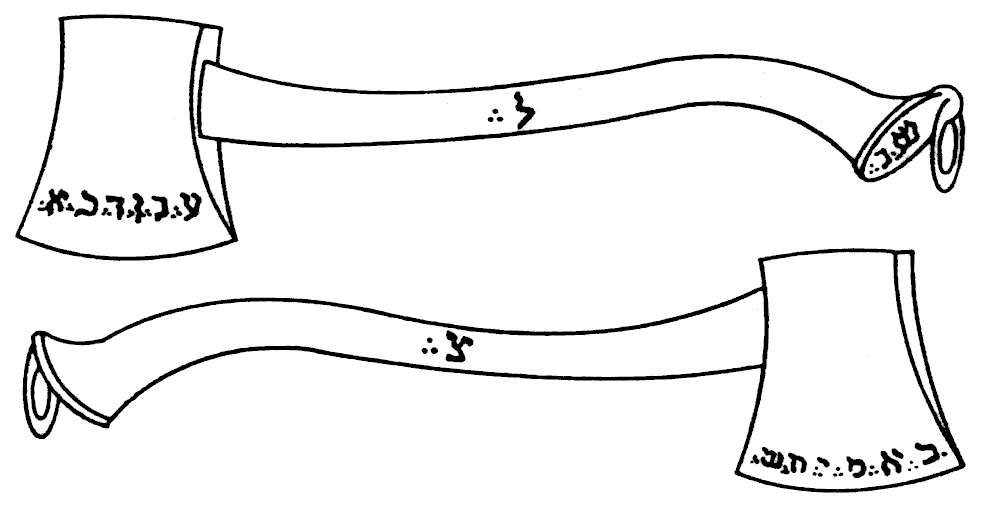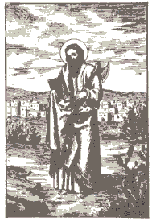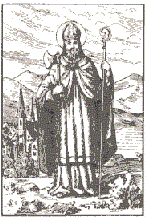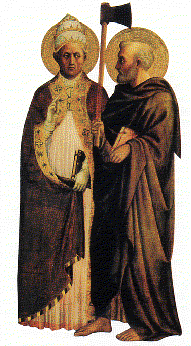The Symbolism of the Axe
by Harold Meij

The axe is one of the most prominent symbols
of the 22nd Degree of the Scottish Rite (Knight Royal Axe, Prins of
Libanus). Such axes were said to have been used to cut down cedars used in the
building of King Solomon's Temple, The Ark of the Convenant, and even Noah's
Ark. The initials on the axe are those of Solomon and Noah, whereas the initials
on the handle are those of Libanus and Tsidun, Libanus referring to the area
where the cedars were found, and Tsidun, the city whose people helped cut down
the trees. The initials on the one side of the blade are said to be those of
Shem, Ham, Japheth (The three sons of Noah), Moses, Aholiab, and Bezaleel (who
together led a large group of workers who worked in fine metals, rare wood, and
precious stones). Initials on the other side of the blade are those of Adoniram
(civil servant responsible for acquiring laborers), Cyrus (original issuer of
decree allowing the rebuilding of the Temple), Darius (who re-issued Cyrus's
decree and provided for all costs from royal revenue), Zerubbabel (credited with
the Temple's reconstruction), Nehemiah (who rebuilt Jerusalem's walls) and Ezra
(to collect contributions from the Babylonian Jews). These initials appear to
represent the prominent people who, in their own ways, helped rebuild the
Temple.
The axe is one of the oldest tools of modern man. As with so
many symbols, it has an dualistic association, in this case representing both
destruction and creation.
In pre-historic times, axes were made from stone, which
sometimes created sparks. Many ancient cultures associated sparks with thunder,
which in turn was known to have great powers. American Indians, the Chinese and
even the Celts called axes "thunder stones". As such, axes became closely
associated with power, both the power of destruction, and the power of
creation
Thunder led the axe to become an important symbol of power.
Axes were often depicted on Chinese robes worn by top officials, representing
the Emperor’s power
to guide the nation through tough times if need be. Similar usage is often also
seen in European heraldry, where a lion or other powerful animal is shown
holding an axe as a symbol of the nations, or its leader’s, powers. Other flags prominently show
an exe, including those of the Royal Standard of Norway, Telemark (also Norway),
Santa Isabel Province (Solomon Islands), and Toporiv in the Ukraine.
The axe is most often used as a symbol of creation. As axes
were closely associated with thunder, it also naturally became associated with
rain, an important giver of life. Axes were also an essential tool in spreading
civilizations. This is the context in which the symbol is used in the
22nd Degree. Using the axe to represent the spreading of
civilizations can also been seen in flags. For example, the coat-of-arms of
Brazilian municipality of Brusque shows an axe, added there to remember the
"pioneering work of the first settlers and explorers". It is also a German
tradition to strike a blow with an axe at the site of a new building. This
custom originated from the legend of St. Wolfgang, who after having selected a
solitary spot in the wilderness, prayed, and then threw his axe into the
thicket; the spot on which the axe fell he regarded as the place where God
intended he should build his place.

An example of a
double-axe
The axe is also a symbol of destruction, as it can be used as a
weapon, as was often the case with a weapon known as a battle-axe. This was
probably an older usage of the symbol, as the earliest axes must have been
double sided stones attached to an end of a piece of wood to serve as a tool.
As axes were often used for killing large animals intended as a
sacrifice, some cultures associated the axe with sacrifices. This especially
grew since martyrs such as Barnabus, Matthew, and Matthias were executed with an
axe, and were often portrayed with one.



St. Matthew (W Auer 1890)
|
St. Wolfgang (W Auer 1890)
|
15th Century depiction of St. Matthias
|
back to top |
![]()










